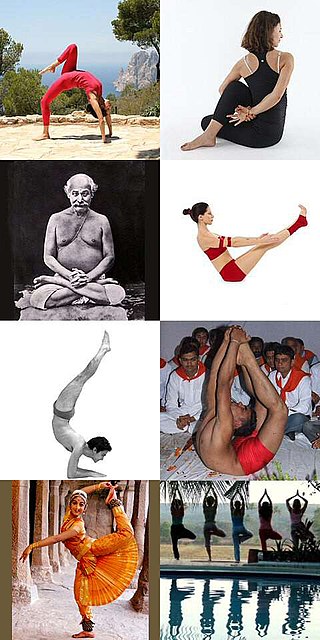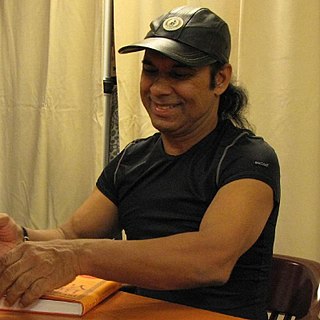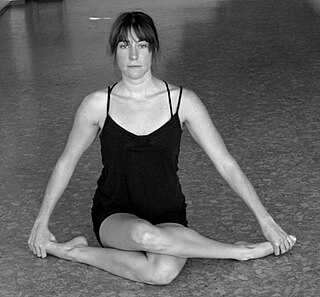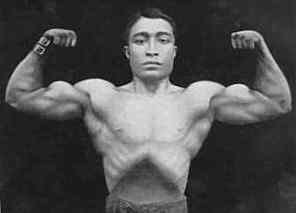Related Research Articles

Bikram Yoga is a system of hot yoga, a type of yoga as exercise, devised by Bikram Choudhury and based on the teachings of B. C. Ghosh, that became popular in the early 1970s. Classes consist of a fixed sequence of 26 postures, practised in a room heated to 105 °F (41 °C) with a humidity of 40%, intended to replicate the climate of India. The room is fitted with carpets and the walls are covered in mirrors. The instructor may adjust the students' yoga postures. Choudhury's teaching style was abrasive.

Ashtanga vinyasa yoga is a style of yoga as exercise popularised by K. Pattabhi Jois during the twentieth century, often promoted as a modern-day form of classical Indian yoga. Jois claimed to have learnt the system from his teacher Tirumalai Krishnamacharya. The style is energetic, synchronising breath with movements. The individual poses (asanas) are linked by flowing movements (vinyasas).

An āsana is a body posture, originally and still a general term for a sitting meditation pose, and later extended in hatha yoga and modern yoga as exercise, to any type of position, adding reclining, standing, inverted, twisting, and balancing poses. The Yoga Sutras of Patanjali define "asana" as "[a position that] is steady and comfortable". Patanjali mentions the ability to sit for extended periods as one of the eight limbs of his system. Asanas are also called yoga poses or yoga postures in English.

Bikram Choudhury is an Indian-American yoga guru, and the founder of Bikram Yoga, a form of hot yoga consisting of a fixed series of 26 postures practised in a hot environment of 40 °C (104 °F). The business became a success in the United States and then across the Western world, with a variety of celebrity pupils. His former wife Rajashree Choudhury assisted him in the yoga business.

Shavasana, Corpse Pose, or Mritasana, is an asana in hatha yoga and modern yoga as exercise, often used for relaxation at the end of a session. It is the usual pose for the practice of yoga nidra meditation, and is an important pose in Restorative Yoga.

Tree pose or Vrikshasana is a balancing asana. It is one of the very few standing poses in medieval hatha yoga, and remains popular in modern yoga as exercise. The pose has been called iconic of modern yoga; it is often featured in yoga magazines, and practised in public displays such as for the International Day of Yoga.

Ustrasana, Ushtrasana, or Camel Pose is a kneeling back-bending asana in modern yoga as exercise.
William "Terry" W. Fisher III is the WilmerHale Professor of Intellectual Property Law at Harvard Law School and faculty director of the Berkman Klein Center for Internet & Society. His primary research and teaching areas are intellectual property law and legal history.

Yin Yoga is slow-paced style of yoga as exercise, incorporating principles of traditional Chinese medicine, with asanas (postures) that are held for longer periods of time than in other styles. Advanced practitioners may stay in one asana for five minutes or more. The sequences of postures are meant to stimulate the channels of the subtle body known as meridians in Chinese medicine and as nadis in Hatha yoga.

Hot yoga is a form of yoga as exercise performed under hot and humid conditions, resulting in considerable sweating. Some hot yoga practices seek to replicate the heat and humidity of India, where yoga originated. Bikram Choudhury has suggested that the heated environment of Bikram Yoga helps to prepare the body for movement and to "remove impurities".
Yoga to the People was a chain of United States-based yoga studios which offered free or donation-funded modern yoga classes to any kind of student, including casual practitioners.

Utthita Hasta Padangusthasana, Standing Big Toe Hold or Extended Hand-to-Big-Toe Pose is a standing balancing asana in modern yoga as exercise.

Yoga as exercise is a physical activity consisting mainly of postures, often connected by flowing sequences, sometimes accompanied by breathing exercises, and frequently ending with relaxation lying down or meditation. Yoga in this form has become familiar across the world, especially in America and Europe. It is derived from medieval Haṭha yoga, which made use of similar postures, but it is generally simply called "yoga". Academics have given yoga as exercise a variety of names, including modern postural yoga and transnational anglophone yoga.

Bishnu Charan Ghosh was an Indian bodybuilder and Hathayogi. He was the younger brother of yogi Paramahansa Yogananda, who wrote the 1946 book Autobiography of a Yogi. In 1923, he founded the College of Physical Education, Calcutta. His writings influenced the development of modern yoga as exercise in India and Bikram Choudhury founded Bikram Yoga based on his teachings.
Competitive yoga is the performance of asanas in sporting competitions. The activity is controversial as it appears to conflict with the nature of yoga.

Sexual abuse by yoga gurus is the exploitation of the position of trust occupied by a master of any branch of yoga for personal sexual pleasure. Allegations of such abuse have been made against modern yoga gurus such as Bikram Choudhury, Kausthub Desikachar, Amrit Desai, and K. Pattabhi Jois. There have been some criminal convictions and lawsuits for civil damages.

The standing asanas are the yoga poses or asanas with one or both feet on the ground, and the body more or less upright. They are among the most distinctive features of modern yoga as exercise. Until the 20th century there were very few of these, the best example being Vrikshasana, Tree Pose. From the time of Krishnamacharya in Mysore, many standing poses have been created. Two major sources of these asanas have been identified: the exercise sequence Surya Namaskar ; and the gymnastics widely practised in India at the time, based on the prevailing physical culture.

Yoga in the United States has a long history, foreshadowed in the 19th century by the philosophers Ralph Waldo Emerson, whose poem "Brahma" is a statement of the Hindu philosophy behind yoga, and Henry David Thoreau, and starting in earnest with the Hindu leader Vivekananda's visit from India in 1893; he presented yoga as a spiritual path without postures (asanas), very different from modern yoga as exercise. Two other early figures, however, the women's rights advocate Ida C. Craddock and the businessman and occultist Pierre Bernard, created their own interpretations of yoga, based on tantra and oriented to physical pleasure.
The following are the 26 postures of Bikram Yoga, as it names them; some of the Sanskrit names differ from those used for the same or closely related poses in other schools of yoga, and some of them are otherwise used for different poses. The postures include 24 asanas, one pranayama breathing exercise, and one shatkarma, a purification making use of forced breathing. Bikram Yoga was devised by Bikram Choudhury around 1971 when he moved to America.

Postural yoga began in India as a variant of traditional yoga, which was a mainly meditational practice; it has spread across the world and returned to the Indian subcontinent in different forms. The ancient Yoga Sutras of Patanjali mention yoga postures, asanas, only briefly, as meditation seats. Medieval Haṭha yoga made use of a small number of asanas alongside other techniques such as pranayama, shatkarmas, and mudras, but it was despised and almost extinct by the start of the 20th century. At that time, the revival of postural yoga was at first driven by Indian nationalism. Advocates such as Yogendra and Kuvalayananda made yoga acceptable in the 1920s, treating it as a medical subject. From the 1930s, the "father of modern yoga" Krishnamacharya developed a vigorous postural yoga, influenced by gymnastics, with transitions (vinyasas) that allowed one pose to flow into the next.
References
- 1 2 3 4 staff (17 June 2004). "Face value: The litigious yogi". The Economist . Retrieved 23 February 2015.
- ↑ Farrell, Maureen (September 3, 2009). "Bikram Yoga's New Twists". Forbes.com.
- ↑ "Yoga, Inc". Bad Dog Tales. Archived from the original on 2015-02-06. Retrieved 2015-02-23.
- ↑ "Federal Register / Vol. 77, No. 121 / Friday, June 22, 2012 / Rules and Regulations" (PDF). U. S. Government Printing Office. Retrieved 9 February 2013.
- ↑ Steele, Rachel (11 February 2010). "Yoga To The People in New York City (aka Yoga With A Lot of People)". Elephant Journal. Retrieved 20 February 2015.
- ↑ McGrath, Ben (6 February 2012). "Steamed". The New Yorker . Retrieved 23 February 2015.
- ↑ Solomon, Serena (30 November 2011). "Bikram Originator Sues Yoga to the People for 'Stealing' Poses - East Village & Lower East Side". dnainfo.com. Archived from the original on 23 February 2015. Retrieved 23 February 2015.
- ↑ Gray, Rosie (6 December 2011). "Yoga to the People Takes on Bikram Choudhury on Facebook". Village Voice . Retrieved 23 February 2015.
- ↑ Brack, Kate (13 April 2013). "The Fallout From A Downward-Facing Dog Fight | Brooklyn Based". brooklynbased.com. Retrieved 23 February 2015.
- ↑ Coscarelli; Thorn, Max (12 December 2012). "Yoga to the People Settles Lawsuit, Stays Cheap -- NYMag". nymag.com. Retrieved 23 February 2015.
- ↑ Newman, Andy (10 December 2012). "Yoga to the People to Stop Offering Hot Yoga to Settle Bikram Suit - NYTimes.com". cityroom.blogs.nytimes.com. Retrieved 23 February 2015.
- ↑ Hoffman, Meredith (3 January 2013). "Yoga to the People Unveils '26 Plus 6' Bikram Yoga Replacement - Williamsburg - DNAinfo.com New York". dnainfo.com. Archived from the original on 23 February 2015. Retrieved 23 February 2015.
- 1 2 Moss, Rebecca (11 December 2012). "The Hot Yoga War's Messy End: Why Yoga to the People Won't Be Teaching Bikram Yoga Anymore | Village Voice". blogs.villagevoice.com. Retrieved 23 February 2015.
- ↑ Moss, Rebecca (19 December 2012). "Hold that Pose: Federal Judge Rules that Bikram Yoga Cannot be Copyrighted" . Retrieved 27 October 2015.
- ↑ Bloomberg "Yoga, AstraZeneca, Intel, UN: Intellectual Property" https://www.bloomberg.com/news/2012-12-17/yoga-astrazeneca-intel-un-intellectual-property.html
- ↑ BIKRAM’S YOGA COLLEGE OF INDIA, L.P.; BIKRAM CHOUDHURY, v. EVOLATION YOGA, LLC; MARK DROST; ZEFEA SAMSON; and DOES 1 through 10(UNITED STATES DISTRICT COURT CENTRAL DISTRICT OF CALIFORNIA2012)("As such, we hold it unconstitutional."). Text
- ↑ BIKRAM’S YOGA COLLEGE OF INDIA, L.P.; BIKRAM CHOUDHURY, v. EVOLATION YOGA, LLC; MARK DROST; ZEFEA SAMSON(UNITED STATES DISTRICT COURT OF APPEALS FOR THE NINTH CIRCUIT2015)("Because copyright protection is limited to the expression of ideas, and does not extend to the ideas themselves, the Bikram Yoga Sequence is not a proper subject of copyright protection."). Text